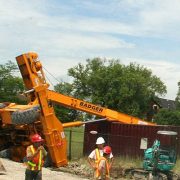Safety tip of the week: A Stable Base
Most elevated work platform accidents occur as the result of tipping. Preventing tipping requires an understanding of balance and constant vigilance; awareness is the first step to safety.
There are two types of elevated platforms: on-slab units and rough terrain units. On-slab units, meant for indoor use such as warehouse work, normally have solid rubber tires and are equipped with a metal plate that can be lowered close to the ground as ‘pothole protection’. Rough terrain units have wider wheel bases, larger wheels and pneumatic tires. Some are equipped with outriggers for increased stability.
Manufactured with safety in mind
Modern elevated work platforms are manufactured to be stable and safe if used in the conditions they were designed for. Manufacturer’s manuals come with load charts showing safe operating configurations. Boom machines with long enough booms to cause tipping often come with radius limiting interlocks, which will prevent the boom from extending too far. Some machines are equipped with alarms that notify the operator when tipping is imminent. But, manufacturers can’t prevent everything.
What causes tipping?
To prevent tipping, you first need to understand why it happens. There are many specific causes, but they all have one thing in common: the unit’s centre of gravity moves. As long as the centre of gravity is over the undercarriage of the vehicle, it won’t tip. Once it moves outside that area, it’s dangerous. The tricky part is, the centre of gravity shifts as the platform or boom is moved. Other things that can change the centre of gravity are sudden stops, overloading, depressions or drop-offs.
What’s under your wheels?
Drop-offs, even on relatively flat concrete slabs, are magnified if the boom is extended. For example, if a boom lift with the boom extended 14 meters hits a 100 mm depression, the end of the boom sways 600 mm. This shifting of weight can cause the machine to tip, or worse, catapult a worker from the platform.
In Boulder, Western Australia in 2010, a worker was killed when his boom lift fell into a large drain that was hidden under the grass surface. In 2012, two workers in Lismore were almost killed when their boom broke through a steel grate holding telecommunications wires.
It is very important to examine the surface where the lift will be operating. Before starting work, always survey the ground, looking at soil type and locating debris and other obstacles. Even on a warehouse floor, there may be indentations, level changes or cracks that could cause an accident.
Other common issues include using an on-slab machine on rough terrain; using an undersized unit, either in weight or reach; extending the platform with planks or ladders because it won’t reach far enough; and failing to assess the needs of the job before starting it.
Trained operators are vital, and it’s the Elevated Work Platform Association of Australia that provides the proper training. You can even get a trained assessor to examine your work site to determine its safety.



